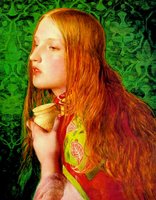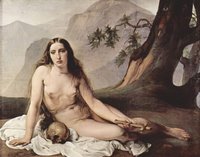
Feast of Mary Magdalene
July 22 is the feast day of Mary Magdalene. I'm travelling and may not have internet access, so I'm posting this early.
Mary Magdalene is one of the most prominent women in the Bible. There are three Marys in the New Testament. One is Mary Magdalene. Mary of Bethany is Lazarus’ and Martha’s sister. Another Mary is a repentant sinner who anointed Jesus’ feet with perfume; she is generally considered to be a prostitute. Roman Catholics have generally considered all three Marys to be Mary Magdalene. Eastern Orthodox Christians generally consider these to be separate persons. In 591, Pope Gregory delivered a sermon that conflated these women’s identities, and this tradition has continued.
She whom Luke calls the sinful woman, whom John calls Mary, we believe to be the Mary from whom seven devils were ejected according to Mark.

Generally, modern scholars believe that Mary Magdalene was not the repentant prostitute. Some scholars have theorized that she was in fact married to Jesus; it was extremely unusual for a Jewish rabbi to be unmarried, violating the commandment to be fruitful and multiply. The evidence is mainly circumstantial, and there is no way to prove or disprove this contention for a fact.

Mary has often been portrayed with long, uncovered hair, which had very sexual connotations at the time. This may be why Paul commands women to cover their hair in church. Mary is also often portrayed with red hair, and there are sexual stereotypes about redheads. The real Mary was not likely to have had red hair; see the Wikipedia entry for geographical distributions of redheads: http://en.wikipedia.org/wiki/Red_hair

Jane Schaberg, a prominent feminist theologian, asks us to take a look at our views of Mary. Men in general tend to see women as either virgins or whores. In Christianity, we have the chaste Virgin Mary, who the Roman Catholic Church teaches was a virgin until her bodily assumption into heaven, and we have Mary Magdalene the repentant prostitute. Joan of Arc was a great military leader, but she also died unmarried and very likely still a virgin. We see sex as impure, and accord a special status to virginity. If not that, then chastity is better than nothing.
On the other end of the scale, we have the repentent whore. In Passion of the Christ, Mary Magdalene was played by Monica Bellucci, with her sexy Italian accent and sexy, um, other assets. Schaberg asks us, why not someone like Helen Mirren? Why all these sexualized images of Mary? Can men, or women, take Mary the sex kitten seriously? And for the more modern possibility, that she was Mrs Jesus, does she have to be married to Jesus to be significant? Could she not have been a major player on her own, not owned by a man?
Those views of women have shaped our perception of the Gospels over the centuries. Mary Magdalene was the first person who the risen Christ revealed himself. And yet, because no women were called as apostles, some Christian denominations deny ordination to women. Mary’s historical role could have been much bigger, but we may never know about it, because her role and the roles of other women could have been obscured from history. And so, it is possible that our theories of Mary are inkblot tests that tell us much more about ourselves than about Mary.
How can distorted perceptions of Mary and of women harm us? Two words: Magdalene Laundries. In 1998, an order of nuns in Dublin, Ireland sold some property off to real estate developers. Buried on that property were the remains of 133 women in unmarked graves. They were virtual prisoners of the Catholic Church, sent there for perceived or actual sins of the flesh to live in servitude. The stigma attached to promiscuity around the 1950s was so strong that if they had not become prisoners, they would have become homeless. In those days, the church was the state, so they became prisoners of the church.
CBS broadcast the story, and interviewed some ex-Magdalenes. They essentialy prisoners at hard labor, except that they never knew when they would get out. You could be claimed by a relative willing to take responsibility, but the chances of that were slim. Few were aware of the laundries, and no one knew what went on behind the walls. And unmarried mothers had their children taken away from them, and they were often given up for adoption.
There are two questions here for the Church in Ireland. One, how could you do this? Two, how could you possibly do this in the name of God? There has been no willingness to dialog on this issue, attempts to stonewall compensation claims, and the church took a long time to release the names of those buried in unmarked graves. It is as if they are stonewalling until the media forgets about this. Only Bishop Willie Walsh of Killaloe was willing to talk to CBS and express regret.
Here’s the link to the story: http://www.cbsnews.com/stories/2003/08/08/sunday/main567365.shtml
More info at: www.magdalenelaundries.com
So, in view of all that, we have to choose which Mary to follow. I choose Mary the activist. For centuries, Christians have shared painted eggs on Easter Sunday, representing the new life of Christ. One tradition concerning Mary holds that she used her position to gain an invitation to a banquet by Tiberius Caesar. When she met the Emperor, she held a plain egg in her hand, and exclaimed, “Christ is risen!” Caeser laughed, saying that Christ could no more rise from the dead than the egg could turn red. Before he finished speaking, though, the egg turned red, and Mary proclaimed the Gospel to the entire Imperial house.

This icon of Mary by Robert Lentz was commisioned for Grace Cathedral in San Fransisco, to commemorate the consecration of Barbara Harris as a suffragan bishop. This Mary is gazing intently at the viewer, the egg in her hand about to turn bright red. Christianity is as much about the moment before the Resurrection as after it – has God deserted us, is it all really over, did they really kill Jesus? Faith deserts us, leaves us blind. But this Mary has witnessed the Resurrection herself.
Barbara Harris is the first female bishop consecrated in the Episcopal Church, and she is also African-American. Mary’s name is written across the bottom of the icon in Syriac, a dialect of Aramic. Lentz says, “The Gospel comes to us, not from Rome or Greece, but from the deserts of the Middle East. We owe our faith to Semitic Christians like Mary Magdalene. With this debt in mind, we should hear her voice in Palestinian cries for justice in our day.”
And I would like to add: we need more women in church! We need women in Christian history. We need women pioneers like the Philadelphia Eleven, the first eleven women to be ordained (albeit irregularly) in the Episcopal Church, like my friend who is a priest, a woman, a lesbian, a partner and a mother. We need women willing to die for their faith, like Mary Dyer, a Quaker activist executed in Massachusetts when Quakerism was illegal, like the four nuns executed in El Salvador by a death squad for helping refugees fleeing the civil war. We need women who are liberators, like Elizabeth Cady Stanton, promiment feminist critic of religion; like Mother Jones and Dorothy Day, promiment labor activists. Christianity has been limited by the images it presents to us. Come, help us reshape it.


No comments:
Post a Comment